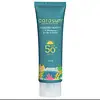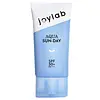What's inside
What's inside
 Key Ingredients
Key Ingredients

 Benefits
Benefits

 Concerns
Concerns

 Ingredients Side-by-side
Ingredients Side-by-side

Water
Skin ConditioningButylene Glycol
HumectantButyl Methoxydibenzoylmethane
UV AbsorberEthylhexyl Methoxycinnamate
UV AbsorberCetearyl Alcohol
EmollientCetyl Alcohol
EmollientIsohexadecane
EmollientPolymethyl Methacrylate
Octocrylene
UV AbsorberPolyacrylamide
Phenoxyethanol
PreservativePolyglyceryl-4 Caprate
EmulsifyingAmmonium Polyacryloyldimethyl Taurate
Emulsion StabilisingLaureth-7
EmulsifyingOryza Sativa Extract
AbsorbentTrehalose
HumectantTrimethoxybenzylidene Pentanedione
AntioxidantC13-14 Isoparaffin
EmollientKaolin
AbrasivePropanediol
SolventLecithin
EmollientEthylhexylglycerin
Skin ConditioningPropylene Glycol
HumectantDMDM Hydantoin
PreservativeArtemisia Capillaris Flower Extract
Skin ConditioningWater, Butylene Glycol, Butyl Methoxydibenzoylmethane, Ethylhexyl Methoxycinnamate, Cetearyl Alcohol, Cetyl Alcohol, Isohexadecane, Polymethyl Methacrylate, Octocrylene, Polyacrylamide, Phenoxyethanol, Polyglyceryl-4 Caprate, Ammonium Polyacryloyldimethyl Taurate, Laureth-7, Oryza Sativa Extract, Trehalose, Trimethoxybenzylidene Pentanedione, C13-14 Isoparaffin, Kaolin, Propanediol, Lecithin, Ethylhexylglycerin, Propylene Glycol, DMDM Hydantoin, Artemisia Capillaris Flower Extract
Water
Skin ConditioningDibutyl Adipate
EmollientEthylhexyl Salicylate
UV AbsorberIsododecane
EmollientPropanediol
SolventDiethylamino Hydroxybenzoyl Hexyl Benzoate
UV FilterEthylhexyl Triazone
UV AbsorberPropylene Glycol
HumectantSilica
AbrasivePhenylbenzimidazole Sulfonic Acid
UV AbsorberTriethanolamine
BufferingTitanium Dioxide
Cosmetic ColorantBis-Ethylhexyloxyphenol Methoxyphenyl Triazine
Skin ConditioningCaprylic/Capric Triglyceride
MaskingPotassium Cetyl Phosphate
EmulsifyingSodium Acrylate/Sodium Acryloyldimethyl Taurate Copolymer
Emulsion StabilisingPhenoxyethanol
PreservativeSodium Polyacrylate
AbsorbentIsohexadecane
EmollientCetyl Alcohol
EmollientGlyceryl Stearate
EmollientChlorphenesin
AntimicrobialPolyhydroxystearic Acid
EmulsifyingStearic Acid
CleansingPolysorbate 80
EmulsifyingPEG-75 Stearate
Alumina
AbrasiveDisodium EDTA
Tocopheryl Acetate
AntioxidantXanthan Gum
EmulsifyingGlycerin
HumectantCeteth-20
CleansingSteareth-20
CleansingSorbitan Oleate
Emulsifying1,2-Hexanediol
Skin ConditioningBiosaccharide Gum-4
Skin ConditioningPolygonum Aviculare Extract
EmollientPotassium Sorbate
PreservativeSodium Benzoate
MaskingMelanin
Skin ProtectingPentylene Glycol
Skin ConditioningEthylhexylglycerin
Skin ConditioningWater, Dibutyl Adipate, Ethylhexyl Salicylate, Isododecane, Propanediol, Diethylamino Hydroxybenzoyl Hexyl Benzoate, Ethylhexyl Triazone, Propylene Glycol, Silica, Phenylbenzimidazole Sulfonic Acid, Triethanolamine, Titanium Dioxide, Bis-Ethylhexyloxyphenol Methoxyphenyl Triazine, Caprylic/Capric Triglyceride, Potassium Cetyl Phosphate, Sodium Acrylate/Sodium Acryloyldimethyl Taurate Copolymer, Phenoxyethanol, Sodium Polyacrylate, Isohexadecane, Cetyl Alcohol, Glyceryl Stearate, Chlorphenesin, Polyhydroxystearic Acid, Stearic Acid, Polysorbate 80, PEG-75 Stearate, Alumina, Disodium EDTA, Tocopheryl Acetate, Xanthan Gum, Glycerin, Ceteth-20, Steareth-20, Sorbitan Oleate, 1,2-Hexanediol, Biosaccharide Gum-4, Polygonum Aviculare Extract, Potassium Sorbate, Sodium Benzoate, Melanin, Pentylene Glycol, Ethylhexylglycerin
Ingredients Explained
These ingredients are found in both products.
Ingredients higher up in an ingredient list are typically present in a larger amount.
Cetyl Alcohol is a fatty alcohol. Fatty Alcohols are most often used as an emollient or to thicken a product.
Its main roles are:
Though it has "alcohol" in the name, it is not related to denatured alcohol or ethyl alcohol.
The FDA allows products labeled "alcohol-free" to have fatty alcohols.
Learn more about Cetyl AlcoholEthylhexylglycerin (we can't pronounce this either) is commonly used as a preservative and skin softener. It is derived from glyceryl.
You might see Ethylhexylglycerin often paired with other preservatives such as phenoxyethanol. Ethylhexylglycerin has been found to increase the effectiveness of these other preservatives.
Isohexadecane is added to enhance texture, emulsify, and to help cleanse. It is an isoparrafin. It is a component of petrolatum.
Due to its large size, Isohexadecane is not absorbed by the skin. Instead, it sits on top and acts as an emollient. Emollients help keep your skin soft and smooth by trapping moisture within.
Isohexadecane is often used in products designed to help oily skin. It is lightweight and non-greasy while helping to moisturize. When mixed with silicones, it gives a product a silky feel.
Learn more about IsohexadecanePhenoxyethanol is a preservative that has germicide, antimicrobial, and aromatic properties. Studies show that phenoxyethanol can prevent microbial growth. By itself, it has a scent that is similar to that of a rose.
It's often used in formulations along with Caprylyl Glycol to preserve the shelf life of products.
Propanediol is an all-star ingredient. It softens, hydrates, and smooths the skin.
It’s often used to:
Propanediol is not likely to cause sensitivity and considered safe to use. It is derived from corn or petroleum with a clear color and no scent.
Learn more about PropanediolPropylene Glycol is an odorless, colorless liquid. As a humectant, it helps skin retain moisture. It also aids in delivering active ingredients.
Another role of this ingredient is preventing a product from melting or freezing. Propylene glycol also adds antimicrobrial properties to a product, elongating product lifespan.
This ingredient is considered an organic alcohol and commonly added into both cosmetics and foods.
Those with sensitive skin or conditions may develop a rash when using this ingredient.
Learn more about Propylene GlycolWater. It's the most common cosmetic ingredient of all. You'll usually see it at the top of ingredient lists, meaning that it makes up the largest part of the product.
So why is it so popular? Water most often acts as a solvent - this means that it helps dissolve other ingredients into the formulation.
You'll also recognize water as that liquid we all need to stay alive. If you see this, drink a glass of water. Stay hydrated!
Learn more about Water